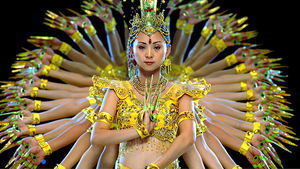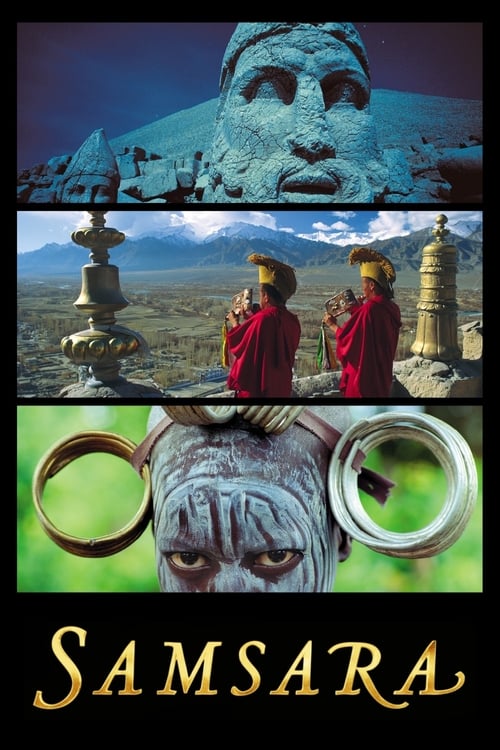Cast
View AllNi Made Megahadi Pratiwi
as Dancer: Valinese Tari Legong Dancers, Indonesia
Puti Sri Candra Dewi
as Dancer: Valinese Tari Legong Dancers, Indonesia
Putu Dinda Pratika
as Dancer: Valinese Tari Legong Dancers, Indonesia
Marcos Luna
as Tattoo Daddy: USA
Hiroshi Ishiguro
as Professor and Robot Clone: Japan
Olivier De Sagazan
as Man At Desk: France
Ladyboys of Cascade Bar
as Dancers: Thailand
Kikumaru
as Geisha: Japan
Crisanto Neire
as Lead Singer: Cebu Provincial Detenton Center, Philippines
Robert Henline
as US Army Veteran: USA (as Staff Sergeant Robert Henline)
Tai Lihua
as Lead Dancer: 1000 Habds Goddess Dance, China
Collin Alfredo St. Dic
as Self - Cyclist
Crew
Director
- Ron Fricke
Writer
- Mark Magidson
- Ron Fricke
Producer
- Mark Magidson
Reviews
CRCulver
In 1993, filmmakers Ron Fricke and Mark Magidson presented a deeply moving portrait of features universal to all human societies, warned of ecological collapse, and depicted how technology was changing our lives in <i>Baraka</i>. Shot on 70mm film in 30-odd countries, this was one of the most visually impressive films ever made, and its lack of any dialogue or narration allowed viewers to engage in their own individual reflections about the panorama on the screen. Two decades later, the team returned with <i>Samsara</i>, a sequel that wasn't really necessary.
One reason that <i>Samsara</i> is not very good is that it often seems a shot-for-shot repeat of <i>Baraka</i>. The filmmakers revisit many of the same locations (such as Thai prostitutes, a chicken-processing plant, home appliance factories, landfill gleaners). Again Buddhism, the Ka'aba and high church Christianity are depicted, but because the film does not go on to any other religions than what was on <i>Baraka</i>, these rituals feel this time like cheap exoticism instead of unquenchable anthropological curiosity. SAMSARA also lacks the dramatic arc of <i>Baraka</i>, coming across as a random succession of images instead of the journey from sacredness to horror and back that we found in its predecessor.
That is not to say that <i>Samsara</i> is completely without interest. There is an astonishing clip of performance artist Olivier de Sagaza, and the freakish Dubai landscape is depicting in a detail that few (even those who have been there) have seen. <i>Samsara</i> is all in all a darker film, and while depictions of the wreckage of Katrina, a Wyoming family that are proud to own an arsenal of guns, and a wounded veteran may fail to really shock viewers in the West who have already been exposed to such images for years, scenes of garish funerals in Nigeria and Indonesian men making the rounds in a sulphur mine (even though they know it is killing them) are stirring and memorable. Of course the visuals are rich, and in Bluray format on my HD projector the film is just as stunningly detailed as its predecessor.
However, <i>Samsara</i> lacks enough new things to say, it surprisingly doesn't offer continual rewards on rewatching, and just by the fact that it exists out there it potentially dilutes the impact of <i>Baraka</i>, once a singular film. I was entertained enough to give this a 3-star rating, but I would still recommend <i>Baraka</i>, and even for those who have seen and loved <i>Baraka</i>, I would not recommend moving on to this film.
Sep 10, 2018
Thematic Analysis
Samsara represents a fascinating example of Documentary cinema, offering viewers a unique perspective on the human experience and societal structures. The film's approach to its themes demonstrates a creative vision that distinguishes it within its genre.
Director Ron Fricke brings their distinctive visual style to this film, continuing their exploration of themes seen in their previous works while adding new elements. Their approach to pacing and visual storytelling creates a viewing experience that rewards close attention.
Released in 2011, the film exists within a cultural context that continues to evolve with our understanding of its themes. Its critical acclaim reflects its artistic achievements and its place in cinema history.
Did You Know?
- The production of Samsara took approximately 13 months from pre-production to final cut.
- With a budget of $4.0 million, the film represented a significant investment in bringing this story to the screen.
- The final cut of the film runs for 102 minutes, though the director's initial assembly was reportedly 130 minutes long.
- The musical score contains over 55 unique compositions.
- The film contains approximately 1793 individual shots.
- The director insisted on using practical effects whenever possible, reserving CGI for only the most necessary scenes.
Historical Context
- In 2011, when this film is released:
- Streaming services were revolutionizing film and television consumption.
- Political polarization was intensifying in many countries.
- Streaming platforms were disrupting traditional distribution models and changing how audiences consumed films.
How This Film Stands Out
While Samsara shares thematic elements with other films in its genre, it distinguishes itself through its unique approach to storytelling, visual style, and character development.
Unlike Microcosmos, which takes a more conventional approach to its subject matter, Samsara offers a fresh perspective through its innovative visual language and narrative structure.
While films like Koyaanisqatsi and Baraka explore similar territory, Samsara stands apart through its deeper exploration of its central themes and more complex characterization.
This film's unique contribution to cinema lies in its bold artistic choices and willingness to challenge viewer expectations, making it a valuable addition to its genre.
Details
- Release Date: September 16, 2011
- Runtime: 1h 42m
- Budget: $4,000,000
- Revenue: $2,639,616
Where to Watch








